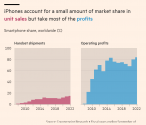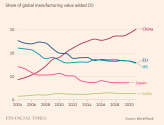Part 2 of FT's series on China and Apple.
Some quotes:
All hope lies on India.
More issues.
What about Vietnam?
Mainland firms are in fact winning contracts at the expense of Taiwanese companies.
Apple is now ceding control to Chinese engineers, whereas before all the top dogs were flown in from California.
There's more to the story, but I think that's enough. Why do people obsess over Apple? Because they control 80% of industry profits and have the most exacting standards.

As for Chinese manufacturing, the data is very clear: the world is becoming more - not less - dependent on China.

Some quotes:
Apple’s dilemma on China is over two decades in the making, going to the foundation of its global success. For Cook, it’s personal. The operations guru was the architect of Apple’s China-oriented supply chain strategy, earning a reputation for obsessing over details that transformed its end-to-end management into the envy of the tech world.
But Apple’s reliance on the country for its annual cadence of product refreshes is now arguably its biggest vulnerability.
“Apple can’t diversify,” says one former Apple engineer who had been tasked with finding ways to automate production to overcome rising labour costs. This person says the iPhone maker has been striving to move its operations outside China since at least 2014, but with little progress to show for it. “China is going to dominate labour and tech production for another 20 years.”
All hope lies on India.
The candidate in the best position to become a rival to China as a new hub of manufacturing is India, which is expected to surpass it as the world’s most populous country this year.
But some supply chain experts argue that the growth numbers in iPhone “manufacturing” in India are more hype than reality.
Most operations that suppliers have set up for Apple in India are known as FATP — Final Assembly, Test and Pack — a labour-intensive process performed with components largely flown in from China and then assembled mostly by Taiwanese companies.
Pegatron and Foxconn may be moving there, says Steven Tseng, tech analyst at Bloomberg Intelligence, but their suppliers are not. “There is no supply chain in India,” he says. “They have to import pretty much everything from China.”
And although 200mn phones were made in India last year, they are not in the same league as Apple’s products. The most popular models typically sell for $250 or less, while average iPhones cost nearly $1,000 and require more sophisticated automation and labour intensity.
“It’s like comparing a Kia Sorento with a Ferrari,” says a former Microsoft executive. “It’s a way more technically advanced device, a more finessed product.”
More issues.
Experts worry the country lacks the same skill sets, migrant labour pools, infrastructure or supportive government that makes China so attractive to Apple.
“The infrastructure in India is obviously not as well established,” Tseng says. “The transportation, utilities, communication can all be issues. And the labour quality in India — whether it can be the same as in China — is a big question mark.”
What about Vietnam?
Vietnam seems like an attractive alternative, especially as average wages today are less than half that of China’s. JPMorgan estimates that Vietnam will by 2025 account for a majority of AirPods production, 20 per cent of iPads and Apple Watches and 5 per cent of MacBooks.
But other companies have stumbled there. After the Finnish telecoms company Nokia was acquired by Microsoft in 2013, its China factories were closed and production was consolidated to Vietnam, in the hopes of cutting costs and boosting efficiency.
But Nokia quickly ran into problems with organised crime, inadequate transportation and unpredictable weather that would shut down trading ports.
“It was incredibly challenging in terms of ramp up, set up, and getting that working the way it was working in China,” the former Microsoft executive says. “The infrastructure was either very new and hadn’t been proven — or it didn’t exist.”
The executive says Vietnam is still “years and years” away from building competitive operations for technical manufacturing, while the broader logistics challenge is probably even greater.
“We had challenges with sourcing components, because all of our tier-two, tier-three sourcing was still all in China,” this person adds. “So we ended up shipping a lot of semi-finished goods from China to Vietnam for final assembly.”
Even if Vietnam does improve the quality of its operations, experts point out that the south-east Asian nation is just too small to actually rival Apple’s current set-up.
Mainland firms are in fact winning contracts at the expense of Taiwanese companies.
Even as Apple is attempting to diversify its supply chain internationally, its ties to China are simultaneously becoming stronger.
For years, the tech giant has been establishing closer ties with mainland Chinese companies in exchange for concessions to operate more freely.
Cook even personally forged a five-year agreement in 2016 to spend more than $275bn to help advance China’s economy and workforce, according to specialist tech publication The Information.
Apple has since given lucrative orders to Chinese contract manufacturers Luxshare, Goertek and Wingtech, helping to establish a so-called “” at the expense of Taiwanese suppliers Foxconn, Wistron and Pegatron.
JPMorgan now forecasts Chinese companies’ share of iPhone manufacturing will rise from 7 per cent last year to 24 per cent by 2025.
Apple is now ceding control to Chinese engineers, whereas before all the top dogs were flown in from California.
However, Apple risks losing some control over its production process innovations with the “red supply chain.” One reason is it no longer owns as much production machinery at its suppliers’ plants — a strategy that gave the company unprecedented control over how its products were made.
The value of Apple’s “long-lived assets” in China peaked in 2018, at $13.3bn, and in the years since has nearly halved to $7.3bn. Former Apple engineers that spent time in China say that after iPhone sales peaked in 2015 the company was happy to be more reliant on suppliers’ machinery to save costs.
A second loss of control was the result of Covid-19. Blair says “a huge, huge part of [Apple’s] secret sauce” is how frequently its top talent from California would travel to China and spend months at its suppliers’ plants. Pre-pandemic, such trips had become so common that the company was booking “50 business class seats daily” from San Francisco to Shanghai, according to an accidental leak from United Airlines.
But since 2020, Apple has been unable to send troops of engineers to China.
Two former Apple manufacturing engineers say the company’s Chinese engineers really stepped up and proved themselves. “Apple provided a training ground for Chinese manufacturing engineering that was second to none,” one person says. Apple, in turn, raised their pay and has been able to retain most of the team despite frequent recruiting efforts from rivals.
However, two people familiar with Apple’s operations say that giving up control risks slowing innovation and leaking intellectual property. “The Cupertino guys stood back and let the Chinese take the lead,” says one. “The Chinese guys completely control the product now.”
There's more to the story, but I think that's enough. Why do people obsess over Apple? Because they control 80% of industry profits and have the most exacting standards.

As for Chinese manufacturing, the data is very clear: the world is becoming more - not less - dependent on China.

